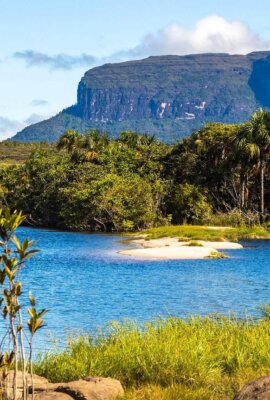Your full Wanderlust guide to
Colombia

Colombia is the only country in South America blessed with both Pacific and Caribbean coastlines. It’s also the second most biodiverse country in the world, boasting over 4,200 species of orchid and over 1,900 bird species. This biodiversity, spanning multiple altitudes, biomes and climates, means that Colombia is rich not only in natural phenomena but also gastronomic flavour, Indigenous cultures and languages, and intricate musical rhythms.
Whether you head for the abundant coffee region, the sweeping coastal sand dunes in La Guajira, the lush jungle in the Amazonía region or you scale the heights of the Andes mountains, Colombia offers a lifetime of meaningful adventures and rich cultural experiences that will stay with you long after you return home.
You can’t miss

When to go to Colombia
Colombia’s dry season, or verano (summer) is December to March, with a second dry period mid-June to mid-August (except in the northern plains). These are the best times to visit and when most festivals take place. Temperatures are fairly constant year round, varying with altitude more than season.
International airports
Bogotá’s El Dorado Airport (BOG) is 15km away from the city centre. From the UK, there are direct flights with avianca from London Heathrow. You can also fly via Madrid with Iberia or Air Europa, via Paris with Air France, or via Amsterdam with KLM. Flight time is approximately 11 hours; return fares start from £700.
Getting around in Colombia
Bus services on paved roads are generally good. Many small towns are served by minibuses or shared taxis known as colectivos on journeys of up to three hours, leaving when the vehicle is full. Domestic flights in Colombia are a good option if you’re short on time and are generally not too expensive; look at airlines such as LATAM, avianca, Wingo and JetSmart. If driving or cycling, be extremely careful due to occasionally poor road conditions and speeding drivers.
Health & safety
Visit your GP or travel health clinic well before departure to check that your jabs are up-to-date. Ideally, bring your yellow fever inoculation certificate to Colombia. Wear DEET repellent to ward off mosquitoes. Protection from the sun is essential. Altitude sickness is a risk in the mountains, particularly in Bogotá which is at 2,625m altitude – try to acclimatise slowly. Drink bottled or purified water. The main places to guard against opportunistic crime are bus stations, unlicensed cabs, markets and when leaving clubs. Don’t have your mobile phone, camera or glistening jewellery too obviously on display, particularly when walking through busy urban streets.
Visit gov.uk for more advice.

















